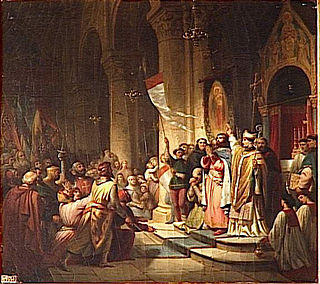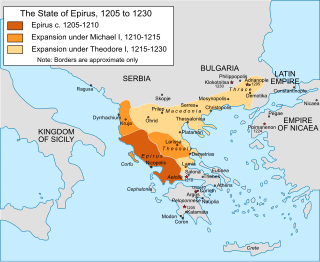Constantinian dynasty (306–363)
| | This section is empty. You can help by adding to it. (July 2010) |
This is a list of the treaties and agreements signed during the history of the Eastern Roman or Byzantine Empire. The definition of a treaty is any agreement between the Byzantine Empire and any foreign power, including peace agreements, trade agreements, and understandings between the two powers. For external conflicts see Byzantine wars.
| | This section is empty. You can help by adding to it. (July 2010) |
| | This section is empty. You can help by adding to it. (July 2010) |
| | This section is empty. You can help by adding to it. (July 2010) |
| | This section is empty. You can help by adding to it. (July 2010) |
| | This section is empty. You can help by adding to it. (July 2010) |
| | This section is empty. You can help by adding to it. (July 2010) |
| | This section is empty. You can help by adding to it. (March 2019) |
| | This section is empty. You can help by adding to it. (July 2010) |
| | This section is empty. You can help by adding to it. (July 2010) |
| | This section is empty. You can help by adding to it. (July 2010) |

Year 1261 (MCCLXI) was a common year starting on Saturday of the Julian calendar.

The Latin Empire, also referred to as the Latin Empire of Constantinople, was a feudal Crusader state founded by the leaders of the Fourth Crusade on lands captured from the Byzantine Empire. The Latin Empire was intended to replace the Byzantine Empire as the Western-recognized Roman Empire in the east, with a Catholic emperor enthroned in place of the Eastern Orthodox Roman emperors. The main objective of the Latin Empire was planned by Venice, which promoted the creation of this state for their self-benefit.

The Empire of Nicaea or the Nicene Empire was the largest of the three Byzantine Greek rump states founded by the aristocracy of the Byzantine Empire that fled when Constantinople was occupied by Western European and Venetian armed forces during the Fourth Crusade, a military event known as the Sack of Constantinople. Like the other Byzantine rump states that formed due to the 1204 fracturing of the empire, such as the Empire of Trebizond and the Despotate of Epirus, it was a continuation of the eastern half of the Roman Empire that survived well into the medieval period. A fourth state, known in historiography as the Latin Empire, was established by an army of Crusaders and the Republic of Venice after the capture of Constantinople and the surrounding environs.

The Bulgarian–Latin wars were a series of conflicts between the Second Bulgarian Empire (1185–1396) and the Latin Empire (1204–61). The wars affected the northern border of the Latin Empire throughout its existence.
Alexios Komnenos Strategopoulos was a Byzantine aristocrat and general who rose to the rank of megas domestikos and Caesar. Distantly related to the Komnenian dynasty, he appears in the sources already at an advanced age in the early 1250s, leading armies for the Empire of Nicaea against Epirus. After falling out of favour and being imprisoned by Theodore II Laskaris, Strategopoulos sided with the aristocrats around Michael VIII Palaiologos, and supported him in his rise to the throne after Theodore II's death in 1258. He participated in the Pelagonia campaign in 1259, going on to capture Epirus, but his successes were undone in the next year and he was captured by the Epirotes. Released after a few months, he led the unexpected reconquest of Constantinople from the Latin Empire in July 1261, restoring the Byzantine Empire. He was captured again by the Epirotes in the next year and spent several years in captivity in Italy, before being released. He retired from public affairs and died in the early 1270s.

The Massacre of the Latins was a large-scale massacre of the Roman Catholic inhabitants of Constantinople, the capital of the Eastern Roman Empire, by the Eastern Orthodox population of the city in April 1182.

The Treaty of Nymphaeum was a peace treaty signed in December 1214 between the Nicaean Empire, successor state of the Byzantine Empire, and the Latin Empire, which was established in the aftermath of the Fourth Crusade of 1204.

The Treaty of Nymphaeum was a trade and defense pact signed between the Empire of Nicaea and the Republic of Genoa in Nymphaion in March 1261. This treaty would have a major impact on both the restored Byzantine Empire and the Republic of Genoa that would later dictate their histories for several centuries to come.

The Nicaean–Venetian Treaty of 1219 was a trade and non-aggression defense pact signed between the Empire of Nicaea and the Republic of Venice, in the form of an imperial chrysobull issued by Emperor Theodore I Laskaris. This treaty provided the Venetians freedom of trade and imports without customs duties throughout the Empire, in exchange for not supporting for the newly created Latin Empire.

The Byzantine civil war of 1321–1328 was a series of conflicts between the Byzantine emperor Andronikos II Palaiologos and his grandson Andronikos III Palaiologos over control of the Byzantine Empire.

The siege of Constantinople in 1260 was the failed attempt by the Nicene Empire, the major remnant of the fractured Byzantine Empire, to retake Constantinople from the Latin Empire and re-establish the City as the political, cultural and spiritual capital of a revived Byzantine Empire.

The Battle of Neopatras was fought in the early 1270s between a Byzantine army besieging the city of Neopatras and the forces of John I Doukas, ruler of Thessaly. The battle was a rout for the Byzantine army, which was caught by surprise and defeated by a much smaller but more disciplined force.
The Byzantine civil war of 1352–1357 was an armed conflict resulting from and following the Byzantine civil war of 1341–1347. The war pitted Byzantine emperor John V Palaiologos against John VI Kantakouzenos and his eldest son Matthew Kantakouzenos. John V emerged victorious as the sole emperor of the Byzantine Empire, but the destruction brought about by the civil war left the Byzantine state in ruins.

The Reconquest of Constantinople was the recapture of the city of Constantinople in 1261 by the forces of the Empire of Nicaea, leading to the re-establishment of the Byzantine Empire under the Palaiologos dynasty, after an interval of 57 years where the city had been the capital of the occupying Latin Empire that had been installed by the Fourth Crusade in 1204.

The Empire of Thessalonica is a historiographic term used by some modern scholars to refer to the short-lived Byzantine Greek state centred on the city of Thessalonica between 1224 and 1246 and ruled by the Komnenodoukas dynasty of Epirus. At the time of its establishment, the Empire of Thessalonica, under the capable Theodore Komnenos Doukas, rivaled the Empire of Nicaea and the Second Bulgarian Empire as the strongest state in the region, and aspired to capturing Constantinople, putting an end to the Latin Empire, and restoring the Byzantine Empire that had been extinguished in 1204.

The Nicaean–Latin wars were a series of wars between the Latin Empire and the Empire of Nicaea, starting with the dissolution of the Byzantine Empire by the Fourth Crusade in 1204. The Latin Empire was aided by other Crusader states established on Byzantine territory after the Fourth Crusade, as well as the Republic of Venice, while the Empire of Nicaea was assisted occasionally by the Second Bulgarian Empire, and sought the aid of Venice's rival, the Republic of Genoa. The conflict also involved the Greek state of Epirus, which also claimed the Byzantine inheritance and opposed Nicaean hegemony. The Nicaean reconquest of Constantinople in 1261 AD and the restoration of the Byzantine Empire under the Palaiologos dynasty did not end the conflict, as the Byzantines launched on and off efforts to reconquer Southern Greece and the Aegean islands until the 15th century, while the Latin powers, led by the Angevin Kingdom of Naples, tried to restore the Latin Empire and launched attacks on the Byzantine Empire.

In 1268, the Byzantine Empire and the Republic of Venice agreed to temporarily end hostilities which had erupted after the Byzantine recovery of Constantinople by Emperor Michael VIII Palaiologos in 1261.
The Byzantine–Venetian treaty of 1277 was an agreement between the Byzantine Empire and the Republic of Venice that renegotiated and extended for two years the previous 1268 treaty between the two powers. The agreement was beneficial for both sides: Byzantine emperor Michael VIII Palaiologos kept the Venetians and their fleet from participating in the attempts of Charles of Anjou to organize an anti-Byzantine crusade, while the Venetians were able to retain their access to the Byzantine market, and even augment their trading privileges by gaining direct access to the Black Sea and the right to their own quarters in Constantinople and Thessalonica. Furthermore, they were able to stop the Byzantine reconquest of Venetian-aligned territories in the Aegean, although the treaty explicitly allowed both sides to continue fighting for control of the island of Euboea (Negroponte). Nevertheless, the agreement's short duration made clear that for both parties, it was a temporary expedient. After the treaty expired, the Venetians allied with Charles of Anjou, but their plans were thwarted by the outbreak of the War of the Sicilian Vespers in 1282, forcing Venice once more to renew the peace with the Byzantines in 1285.
A reason for the longevity of the Byzantine Empire is how they managed their foreign relations. Armed combat and later its navy were the primary methods with the evolved traditions of the Roman Empire, however Byzantine diplomacy which eventuated with their many treaties was used extensively as well.